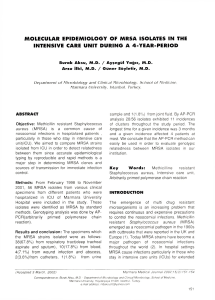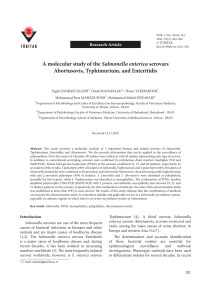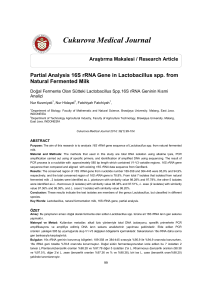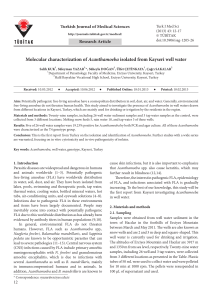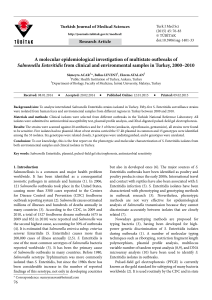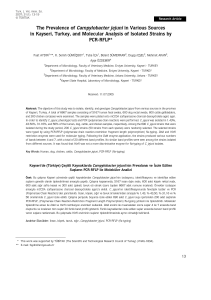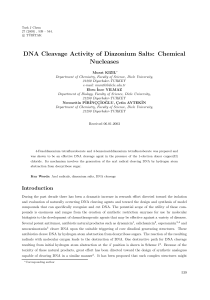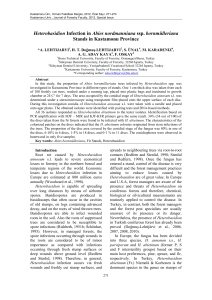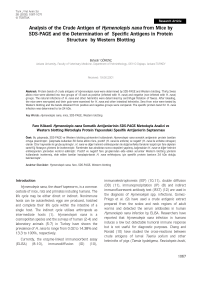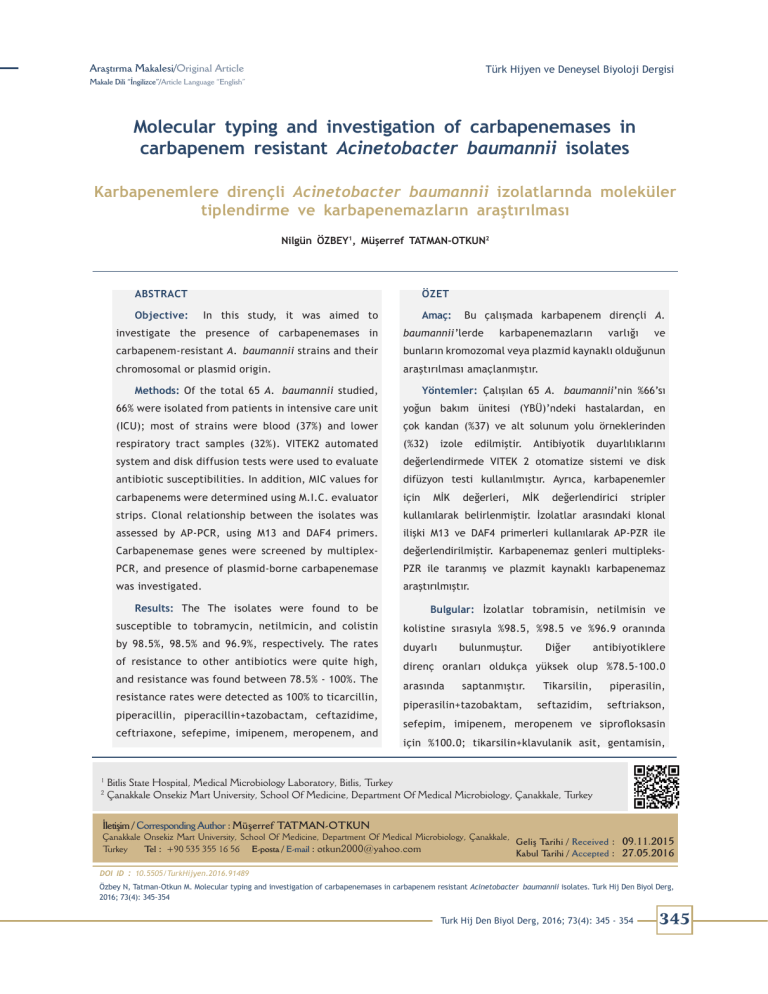
Araştırma Makalesi/Original Article
Türk Hijyen ve Deneysel Biyoloji Dergisi
Makale Dili “İngilizce”/Article Language “English”
Molecular typing and investigation of carbapenemases in
carbapenem resistant Acinetobacter baumannii isolates
Karbapenemlere dirençli Acinetobacter baumannii izolatlarında moleküler
tiplendirme ve karbapenemazların araştırılması
Nilgün ÖZBEY1, Müşerref TATMAN-OTKUN2
ABSTRACT
Objective:
ÖZET
baumannii’lerde
carbapenem-resistant A. baumannii strains and their
bunların kromozomal veya plazmid kaynaklı olduğunun
chromosomal or plasmid origin.
araştırılması amaçlanmıştır.
karbapenemazların
varlığı
ve
Methods: Of the total 65 A. baumannii studied,
Yöntemler: Çalışılan 65 A. baumannii’nin %66’sı
66% were isolated from patients in intensive care unit
yoğun bakım ünitesi (YBÜ)’ndeki hastalardan, en
(ICU); most of strains were blood (37%) and lower
çok kandan (%37) ve alt solunum yolu örneklerinden
respiratory tract samples (32%). VITEK2 automated
(%32)
system and disk diffusion tests were used to evaluate
değerlendirmede VITEK 2 otomatize sistemi ve disk
antibiotic susceptibilities. In addition, MIC values for
difüzyon testi kullanılmıştır. Ayrıca, karbapenemler
carbapenems were determined using M.I.C. evaluator
için
strips. Clonal relationship between the isolates was
kullanılarak belirlenmiştir. İzolatlar arasındaki klonal
assessed by AP-PCR, using M13 and DAF4 primers.
ilişki M13 ve DAF4 primerleri kullanılarak AP-PZR ile
Carbapenemase genes were screened by multiplex-
değerlendirilmiştir. Karbapenemaz genleri multipleks-
PCR, and presence of plasmid-borne carbapenemase
PZR ile taranmış ve plazmit kaynaklı karbapenemaz
was investigated.
araştırılmıştır.
izole
MİK
edilmiştir.
değerleri,
Antibiyotik
MİK
duyarlılıklarını
değerlendirici
stripler
Results: The The isolates were found to be
Bulgular: İzolatlar tobramisin, netilmisin ve
susceptible to tobramycin, netilmicin, and colistin
kolistine sırasıyla %98.5, %98.5 ve %96.9 oranında
by 98.5%, 98.5% and 96.9%, respectively. The rates
duyarlı
of resistance to other antibiotics were quite high,
direnç oranları oldukça yüksek olup %78.5-100.0
resistance rates were detected as 100% to ticarcillin,
piperacillin, piperacillin+tazobactam, ceftazidime,
ceftriaxone, sefepime, imipenem, meropenem, and
2
Bu çalışmada karbapenem dirençli A.
investigate the presence of carbapenemases in
and resistance was found between 78.5% - 100%. The
1
Amaç:
In this study, it was aimed to
bulunmuştur.
arasında
saptanmıştır.
piperasilin+tazobaktam,
Diğer
antibiyotiklere
Tikarsilin,
piperasilin,
seftazidim,
seftriakson,
sefepim, imipenem, meropenem ve siprofloksasin
için %100.0; tikarsilin+klavulanik asit, gentamisin,
Bitlis State Hospital, Medical Microbiology Laboratory, Bitlis, Turkey
Çanakkale Onsekiz Mart University, School Of Medicine, Department Of Medical Microbiology, Çanakkale, Turkey
İletişim / Corresponding Author : Müşerref TATMAN-OTKUN
Çanakkale Onsekiz Mart University, School Of Medicine, Department Of Medical Microbiology, Çanakkale,
Geliş Tarihi / Received : 09.11.2015
Turkey
Tel : +90 535 355 16 56 E-posta / E-mail : [email protected]
Kabul Tarihi / Accepted : 27.05.2016
DOI ID : 10.5505/TurkHijyen.2016.91489
Özbey N, Tatman-Otkun M. Molecular typing and investigation of carbapenemases in carbapenem resistant Acinetobacter baumannii isolates. Turk Hij Den Biyol Derg,
2016; 73(4): 345-354
Turk Hij Den Biyol Derg, 2016; 73(4): 345 - 354
345
CARBAPENEMASES IN A. BAUMANNII ISOLATES
Cilt 73 Sayı 4 2016
ciprofloxacin, 98.5% to ticarcillin+clavulanic acid,
levofloksasin,
gentamicin, levofloxacin, tetracycline, doxycycline,
trimethoprim+sulfametoksazol için %98.5; minosiklin
and
trimethoprim-sulfamethoxazole,
93.8%
tetrasiklin,
doksisiklin
ve
to
için %93.8; amikasin için %92.3 ve ampisilin+sulbaktam
minocycline, 92.3% to amikacin, and 78.5% to
için %78.5 oranında direnç saptanmıştır. AP-PZR ile
ampicillin+sulbactam. In the study, two different
araştırmada iki farklı patern gözlenmiştir. Bütün
patterns were observed by AP-PCR. Chromosomal
OXA-23 and OXA-51 carbapenemase enzyme genes
positively were found in all isolates. Plasmids were
isolated neither of isolates.
Conclusion:
frequently
Isolates
from
were
detected
hemocultures
in
ICU.
more
Isolates
izolatlarda kromozomal kaynaklı OXA-23 ve OXA51 karbapenemaz enzim geni pozitif bulunmuştur.
İzolatların hiçbirinde plazmit izole edilmemiştir.
Sonuç: İzolatlar en sık YBÜ’de yatmakta olan
hastaların kan örneklerinde saptanmıştır. İzolatlar
showed clonal similarity in AP-PCR where M13
M13 ve DAF4 primerlerin kullanıldığı AP-PZR’de
and DAF4 primers were used. The presence of the
klonal benzerlik göstermiştir. Hastanemizde tek
single Acinetobacter clone in our hospital suggests
Acinetobacter
that they all originated from the same source. For
kaynaktan
this reason, it is concluded that universal infection
nedenle karbapeneme dirençli izolatların çapraz
control measures should be taken in consideration
enfeksiyonlarını önlemek için evrensel enfeksiyon
to prevent cross-infection by carbapenem resistant
kontrol önlemlerine dikkat etmek gerektiği sonucuna
isolates.
varılmıştır.
Key
Words: Acinetobacter
baumannii,
oxacillinase, metallo-beta-lactamase, PCR
oksasilinaz, metallo-beta-laktamaz, PZR.
kolonu
köken
bulunması,
aldığını
hepsinin
düşündürmektedir.
Anahtar Kelimeler: Acinetobacter
aynı
Bu
baumannii,
INTRODUCTION
Acinetobacter baumannii is one of the important
Acinetobacter
species
are
gram-negative
causes of nosocomial infections. It is widely present in
coccobacilli, they are immotile and do not have
nature, soil and water, and an opportunistic pathogen
cytochrome oxidase activity. Currently there are at
that
cross-transmission
least 25 genomospecies described within the genus
between patients, leading to colonization or serious
can
cause
nosocomial
Acinetobacter. Because of problems in separating
infections (1).
the saccharolytic strains belonging to DNA groups 1,
broad-spectrum
2, 3 and 13 using phenotypic tests, some laboratories
antibiotics, multiresistant Acinetobacter species
have chosen to report members of this group as
have emerged. The most frequently isolated and
“Acinetobacter
calcoaceticus
–
antibiotic-resistant species in nosocomial infections
complex”,
saccharolytic
Acinetobacter.
is A. baumannii (1). baumannii acidifies most OF (oxidative-fermentative)
As
346
a
result
of
misuse
Turk Hij Den Biyol Derg
of
or
A.
baumannii
A.
N. OZBEY and M. TATMAN-OTKUN
Cilt 73 Sayı 4 2016
carbohydrates; in particular, definitive identification
MATERIALS AND METHODS
is made by demonstrating the rapid production of acid
The study included carbapenem- and multiple-
from lactose or glucose. Furthermore A. baumannii
can grow at 42°C, but other Acinetobacter species
cannot grow. (1).
resistant A. baumannii strains isolated in patients
hospitalized in the School of Medicine Hospital between December 2009 and November 2011. In case
Although Acinetobacter species are currently
of isolation of more than one strain of A. baumannii
less sensitive to carbanepems, they are still among
from the same patient, only one strain was included
the most effective antibiotics. However, changes in
in the study if the antibiotic susceptibility patterns
penicillin-binding proteins, reduced outer membrane
of all isolates were the same.
permeability, and production of chromosomal or
plasmid-induced beta-lactamases (carbapenemases)
cause resistance to carbanepems (2). The most
prevalent mechanism of carbapenem resistance
in A. baumannii is the production of carbapenemhydrolyzing β-lactamases, i.e., metallo-β-lactamases
(ambler class B) and more usually oxacillinases
(ambler class D). Carbapenem-hydrolyzing class D
β-lactamases (CHDLs) are currently classified into six
subgroups; acquired OXA-23-like, OXA-24/40-like,
OXA-58-like, OXA-143-like and OXA-235-like, and the
intrinsic OXA-51-like β-lactamases (3).
A. baumannii produces class D oxacillinase that
belongs to the chromosomal OXA-51-like enzyme
group
showing
weak
carbapenemase
activity.
However, OXA-51-like enzyme is secreted in high
quantities in the presence of ISAba1 gene, causing
high-level carbapenem resistance (4).
Strains isolated and identified as A. calco-
aceticus-A. baumannii complex by a VITEK2 automated system (bioMérieux, France) were stored in
liquid medium with beads (Pro-Lab, Canada) at -80°C
until the time of use. The stored strains and A. baumannii ATCC 19606 strain were subcultured twice on
eosin-methylene blue agar (Salubris, Turkey) at 37°C
for 24 hours. Strains were confirmed as A. baumannii, with acid producing from glucose in OF medium
and growth ability at 42°C.
Disk diffusion tests with standard antibiotic disks
(Oxoid, United Kingdom) were used for susceptibility
tests except for carbapenems and colistin, in addition
to VITEK2 automated system. M.I.C. evaluator strips
(Oxoid, United Kingdom) were used for carbapenem
susceptibility. The susceptibility to antibiotics other
than netilmicin was evaluated according to the CLSI
criteria (6). The susceptibility to netilmicin was eval-
The metallo-beta-lactamases (MBL), the other
uated according to the EUCAST (European Commit-
carbapenemase group, are named because of the
tee on Antimicrobial Susceptibility Testing) criteria
metal ions they carry in their active regions. The
(7). Pseudomonas aeruginosa ATCC 27853 and E. coli
described MBL groups include IMP, VIM, SIM, and SPM.
ATCC 25922 served as the quality control strains (6).
A. baumannii carries various IMP variants (IMP-1,
IMP-2, IMP-4, IMP-5, IMP-6, IMP-8, and IMP-11), but
rarely carries the other enzymes (5).
The purpose of this study was to assess the
presence of carbapenemases of chromosomal and
plasmid origin in carbapenem-resistant A. baumannii
strains isolated in our hospital and also to investigate
the clonal relationship between isolates.
The genomic DNA of A. baumannii isolates and A.
baumannii ATCC 19606 strain was extracted by using
GeneJET Genomic DNA Purification Kit (Fermentas,
United Kingdom) according to the manufacturer’s instructions.
In assessing the clonal relationship between the
isolates, arbitrarily primed polymerase chain reaction (AP-PCR) was performed using the M13 and DAF4
Turk Hij Den Biyol Derg
347
CARBAPENEMASES IN A. BAUMANNII ISOLATES
Cilt 73 Sayı 4 2016
primers (8). The PCR mixture was prepared to have a
final volume of 25 µl. The final mixture contained 1X
buffer solution, 25 pM M13 primer (5’-GAGGGTGGC-
Table 1. Antimicrobial resistance rates of A. baumanii
isolates (NEU Hospital 2010-2014).
GGTTCT-3’), 1.5 mM MgCl2; 400 µM from each dATP,
OXA-23-likeF
5’-GAT CGG ATT GGA GAA CCA GA-3’
dGTP, dCTP, and dTTP; 1 U Taq DNA polymerase,
OXA-23-likeR
5’-ATT TCT GAC CGC ATT TCC AT-3’
OXA-24-likeF
5’-GGT TAG TTG GCC CCC TTA AA-3’
OXA-24-likeR
5’-AGT TGA GCG AAA AGG GGA TT-3’
OXA-51-likeF
5’-TAA TGC TTT GAT CGG CCT TG-3’
follows: at 94˚C for 2 minutes, 35 cycles at 94˚C
OXA-51-likeR
5’-TGG ATT GCA CTT CAT CTT GG-3’
for 20 seconds, at 50˚C for 1 minute, at 72˚C for
OXA-58-likeF
5’-AAG TAT TGG GGC TTG TGC TG-3’
OXA-58-likeR
5’-CCC CTC TGC GCT CTA CAT AC-3’
IMP1-F
5’-CTA CCG CAG CAG AGT CTT TGC-3’
IMP1-R
5’-GAA CAA CCA GTT TTG CCT TAC C-3’
SPM-F
5’-CCT ACA ATC TAA CGG CGA CC-3’
SPM-R
5’-TCG CCG TGC CAG GTA TAA C-3’
nator and photographed. Different band patterns of
VIM-F
5’-TCT ACA TGA CCG CGT CTG TC-3’
the isolates were evaluated. To determine the size
VIM-R
5’-TGT GCT TTG ACA ACG TTC GC-3’
SIM-F
5’-GTA CAA GGG ATT CGG CAT CG-3’
SIM-R
5’-TGG CCT GTT CCC ATG TGA G-3’
and sterile bi-distilled water; and finally 2 µl DNA
was added to this mixture. The same mixture was
prepared using 25pM of DAF4 primer (5’-CGGCAGCGCC-3’). The amplification program for M13 primer
in the thermal cycler (Eppendorf, Germany) was as
20 seconds, and lastly at 72˚C for 5 minutes. The
amplification program for DAF4 primer was as follows: at 94˚C for 2 minutes, 45 cycles at 94˚C for
40 seconds, and at 45˚C for 40 seconds, at 72˚C for
40 seconds, and lastly at 72˚C for 5 minutes. The
obtained PCR product was analyzed with 1% agarose
gel electrophoresis by applying 100 V for 45 minutes
(Wealtec, USA), then studied under UV transillumi-
and quantity, 80-10.000 bp DNA ladder (Fermentas,
United Kingdom) and 1 kb DNA ladder (Fermentas,
United Kingdom) were used and A. baumannii ATCC
19606 was used as the positive control with sterile
deionized water as the negative control.
To assess the presence of carbapenemase in the
isolates, multiplex-PCR was carried with OXA-23,
OXA-24, OXA-51 and OXA-58 as the first group and
then with IMP, VIM, SIM and SPM as the second group,
using the primer pairs shown in Table 1 (9, 10). The
PCR mixture was prepared to have a final volume of
25 µl. The final mixture contained 1X buffer solution, 12.5 pM from each primer, 1.5 mM MgCl2; 200
µM from each dATP, dGTP, dCTP, and dTTP; 1.5 U Taq
DNA polymerase, and sterile bi-distilled water. Lastly, 3 µl DNA extract was added to the solution. The
amplification program was as follows: at 94˚C for 3
minutes, 35 cycles at 94˚C for 45 seconds, at 57˚C
for 45 seconds, at 72˚C for 1 minute, and lastly at 72
˚C for 5 minutes. The obtained PCR product was ana-
348
Turk Hij Den Biyol Derg
lyzed in 1% agarose gel electrophoresis by applying
100 V for 45 minutes (Wealtec, USA), then visualized
under UV lamp and photographed. The presence of
genes was assessed in the bands formed (10, 11). To
determine the size and quantity, 80-10.000 bp DNA
ladder and 1 kb DNA ladder were used. A. baumannii ATCC 19606 was used as the positive control with
sterile deionized water as the negative control. Upstream presence of ISAba1 was not studied.
In order to assess the presence of plasmid-borne
carbapenemase, GeneJET Plasmid Miniprep Kit (Fermentas, United Kingdom) was used according to
the manufacturer’s instructions. To determine the
plasmids, the obtained plasmid DNA was run in 1%
agarose gel electrophoresis by applying 100 V for 45
N. OZBEY and M. TATMAN-OTKUN
Cilt 73 Sayı 4 2016
minutes (Wealtec, USA), then studied under UV lamp
its isolation. This isolate was found to differ from
and photographed, using 80-10.000 bp DNA ladder. As
other isolates by being susceptible to tetracycline,
positive control E. coli strains isolated from patients
doxycycline,
were used with sterile deionized water as negative
susceptible
control.
tobramycin.
and
to
minocycline;
levofloxacin,
and
intermediately
resistant
to
Three isolates from the same patient with
RESULTS
different antibiotic susceptibility patterns were
The 65 clinical isolates of A. baumannii were
included in the study. This patient is a case who
isolated from 62 patients (33 male and 29 female).
Different isolates were obtained from blood and
respiratory secretion of one patient and from two
cerebro-spinal fluid (CSF) specimens and blood of
another patient. The age of the patients ranged from
4 to 91 with a mean age of 60.26±18.20 years. Most
of the isolates (43/65, 66.2%) were from the ICU,
followed by other units ranging from 1.5 to 7.7%. The
isolates were, in order of frequency, blood (24/65,
36.9%), endotracheal aspirate (16/65, 24.6%), wound
(8/65, 12.3%), urine (8/65, 12.3%), sputum (5/65,
7.7%), CSF (2/65, 3.1%), and tissue (2/65, 3.1%)
isolates.
The antibiotic susceptibility results of disk
diffusion
and
VITEK2
automated
system
were
identical. The isolates were most susceptible to
tobramycin and netilmicin for 98.5% and to colistin
for 96.9%. The isolates were highly resistant to other
antibiotics tested. All of the isolates were found
resistant to ticarcillin, piperacillin, piperacillintazobactam, ceftazidime, ceftriaxone, sefepime,
imipenem,
Resistance
meropenem,
rates
to
and
was hospitalized in the ICU with diagnosis of
subarachnoid hemorrhage on December 3, 2010,
was monitored by the Neurosurgery Clinic, and
from whom A. baumannii had been isolated in the
hemoculture on December 20, 2010 (35th isolate).
This 35th isolate was the first isolate from this
patient and its antibiotic susceptibility pattern was
similar to those of other isolates from other patients
and showed susceptibility to colistin. However, two
isolates obtained from the CSF of the same patient
on dates January 25 and February 17, 2011 (37th and
65th isolates, respectively) were found to be colistinresistant. The AP-PCR study showed that all these
three isolates were not different from other isolates.
According to the results of multiplex-PCR test
to assess the presence of oxacillinase and MBL, all
isolates had OXA-23 of size 501 bp and OXA-51 of size
353 bp (Figure 3), but no genes of OXA-24, OXA-58,
IMP-1, SPM, VIM, and SIM were found.
In assessing plasmid-borne carbapenemases, no
plasmids was obtained from the isolates.
ciprofloxacin.
ticarcillin-clavulanic
acid,
gentamicin, levofloxacin, tetracycline, doxycycline,
and trimethoprim-sulfamethoxazole were same and
98.5%. Resistance rates to minocycline, amikacin and
to ampicillin-sulbactam were 93.8%, 92.3% and 78.5%
respectively.
All isolates belonged to same clone except the
33rd isolate with M13 and DAF4 primers in AP-PCR
test (Figures 1 and 2). The 33rd isolate was from a
wound in a patient who had an operation for lumbar
disc hernia in another city two months prior to
DISCUSSION
Nosocomial infections (NIs), causing long
hospitalization, increased morbidity and mortality,
and economic loss due to extra treatment
expenditures, are important. Acinetobacter species
are increasingly isolated as agents of NIs, particularly
of those in ICUs. However, the differentiation of
Acinetobacter spp. needs molecular confirmation
techniques (12). The presence of blaOXA-51 gene
also continues to be an appropriate genetic marker
for A. baumannii identification (13).
Turk Hij Den Biyol Derg
349
Cilt 73 Sayı 4 2016
CARBAPENEMASES IN A. BAUMANNII ISOLATES
Figure 1. Different patterns by M13 primer. M1: 80-10.000 bp DNA ladder, M2: 1 kb DNA ladder, NK: Negative control,
ATCC: A. baumannii 19606
Figure 2. Different patterns by DAF4 primer. M1: 80-10.000 bp DNA ladder, M2: 1 kb DNA ladder, NK: Negative control,
ATCC: A.baumannii 19606
350
Turk Hij Den Biyol Derg
N. OZBEY and M. TATMAN-OTKUN
Cilt 73 Sayı 4 2016
Figure 3. Multiplex PCR results. M2: 1 kb DNA ladder, NK: Negative control, ATCC: A. baumannii 19606
However, blaOXA-51 gene was also found
recently in carbapenem-resistant non-baumannii
species of Acinetobacter: A. nosocomialis (formerly
Acinetobacter
genomic
species
13TU)
and
Acinetobacter genomic species “Close to 13U” (14).
Members of the A. calcoaceticus - A. baumannii
complex are A. calcoaceticus, A. baumannii, genomic
species 3 and genomic species 13TU, so we accepted
our isolates as A. calcoaceticus - A. baumannii
complex. A. baumannii is the most frequently isolated
agent among other species (12). It causes NIs such as
pneumonia, sepsis, meningitis, and urinary infections
in hospitalized patients, particularly among those
treated in ICUs (15). Also in our study, we isolated
A. baumannii most frequently from blood samples
of patients in the ICU. The second most frequent
body site for isolation was lower respiratory tract
from which endotracheal aspirates and sputum were
obtained.
Acinetobacter species are increasingly becoming
multiple-antibiotic resistant, leading to difficulty in
the treatment of infections they cause. Currently, NIs
due to carbapenem-resistant A. baumannii strains
are increasing. According to the results of the MYSTIC
(Meropenem Yearly Susceptibility Test Information
Collection) Antimicrobial Surveillance Program studies
carried out by Hacettepe University, the most effective
antibiotics against A. baumannii were meropenem
by 53%, imipenem by 48%, and tobramycin by 44%
(16). Iraz et al. in their study reported that their
Acinetobacter isolates were susceptible to colistin
and netilmicin at rates of 99% and 85%, respectively
(17). In our study, we found that A. baumannii isolates
were most susceptible to tobramycin, netilmicin and
colistin, whereas they showed minimal susceptibility
to other antibiotics which cannot be considered
for therapy. Generally, many carbapenem resistant
A. baumannii clinical isolates were found to be
resistant to aminoglycosides in many studies. We did not
study the mechanisms for aminoglycoside resistance.
Different resistance genes located on plasmids,
transposons or class I integrons may be responsible
for this resistance (18). It is possible to find different
resistance profiles in different locations; for example
in a study from Australia the carbapenem resistant
isolates have OXA-23 genes, however resistance to
Turk Hij Den Biyol Derg
351
Cilt 73 Sayı 4 2016
CARBAPENEMASES IN A. BAUMANNII ISOLATES
netilmicin has not been found (19). The majority of
our isolates belonged to a single clone, so the unusual
aminoglycoside resistance profile (high resistance to
amikacin compared to high susceptibility to netilmicin
and tobramycin) may be associated with this matter.
results were obtained when standard DNA extraction
and amplification conditions were provided and that
with M13 primer more marked band patterns and thus
better differentiation were obtained when compared
with other primers (8).
The antibiotic resistance of Acinetobacter
species has led investigators to seek other treatment
alternatives. Infections caused by such resistant strains
can be treated with colistin (20). In the last few years,
infections caused by colistin-susceptible Acinetobacter
have emerged and have been successfully treated with
colistin. In our study, colistin was found to be the fourth
most effective antibiotic against A. baumannii. In our
hospital, colistin is used in the therapy of multipleresistant A. baumannii infections since susceptibility
to netilmicin cannot be assessed by VITEK2 automated
system AST-N90 card and since providing tobramycin as
a drug is difficult. However, colistin has some serious
side-effects which render its use problematic. Also,
colistin-resistant and heteroresistant strains which are
difficult to determine have emerged in recent years,
limiting the use of colistin in therapy (21). In our study,
we found two isolates of A. baumannii were resistant
to colistin, namely, isolates numbered (no.) 37 and 65,
belonging to the same patient. Isolate no. 37 was the
first isolate obtained a month prior to isolate no. 65.
Following the isolation of colistin-resistant isolate no.
37, the patient had received colistin therapy which
might have led the present hetero-colistin-resistance
to develop into colistin-resistance.
In our study, we used the M13 and DAF4 primers,
and with each primer we obtained two different
bands, more marked with M13 primer. Isolate no.
33 was accepted as an exogenous isolate since it
was obtained from a patient who had undergone an
operation in another medical center one month prior
to its isolation and showed antibiogram patterns
different from those of other isolates. The same
patterns were shared by all 65 isolates included in
this study except isolate no. 33 which indicates that
there is one single Acinetobacter clone from the same
source in our hospital. Since A. baumannii strains
are occasionally isolated in our hospital since 2009,
it would be more correct to describe this clonal strain
as an endemic strain rather than an epidemic strain.
It is suggested that more attention should be given to
universal infection control measures to prevent the
transmission of bacteria between patients. Studying
environmental samples routinely is not recommended.
However, during epidemics environmental sampling
should definitely be completed to determine the
source of the causative microorganism and to obtain
more relevant data (24).
Since it is not possible to identify Acinetobacter
species with phenotypic methods, genotypic methods
are required for identification (22). PCR-based
methods are widely used for the epidemiologic typing
of A. baumannii. When PCR-based typing is compared
with other methods, it enables differentiation
similar to that of ribotyping, but less than that of
PFGE. Concordance between PFGE, rep-PCR and
MLST for A. baumannii typing has been shown in
various studies (23). In a multi-center study with
participation of different countries, Grundmann et
al. reported that PCRs carried out with isolated A.
calcoaceticus-A. baumannii complex using M13,
DAF4, ERIC2, and REP primer sets gave high rates of
similar results. The authors also reported that similar
352
Turk Hij Den Biyol Derg
The resistance to carbanepems is frequently
associated with acquirement of genes responsible
for the synthesis of carbapenamases which include
oxacillinase and MBLs. Besides these genes, resistance
to carbapenems is also caused by excess production of
OXA-51 type natural oxacillinase (5). Gür et al. (25)
in their study found OXA-58 in 18 (40.9%) and OXA-23
in 26 (59.1%) isolates. A multicenter study in Turkey
reported the presence of OXA-51 in 100%, OXA-23 in
74.4%, and OXA-58 in 17.3% of carbapenem-resistant
A. baumannii isolates, but absence of OXA-24 in all
isolates (26). Another study reported the presence of
OXA-51 in 100% and OXA-23 in 78.2% of carbapenemresistant A. baumannii isolates, but absence of OXA58 in all isolates (27). A study in Greece found OXA-51
in 15 and OXA-58 in 14 of the 17 A. baumannii isolates,
but no OXA-23 and OXA-24 (28). In the same study, the
N. OZBEY and M. TATMAN-OTKUN
enzymes IMP, VIM, SIM, and SPM were investigated by
using Etest and molecular methods, but MBL enzymes
were not found with either method (28). A study in
Brazil reported the presence of OXA-23 in all of 172 A.
baumannii isolates investigated, but absence of IMP,
VIM, SIM, and SPM as MBL enzymes (10).
In our study, we investigated the presence of
oxacillinase enzymes, namely, OXA-23, OXA-24, OXA51, and OXA-58, and presence of MBL enzymes, namely,
IMP, VIM, SIM, and SPM using multiplex-PCR. Since OXA23 and OXA-51 were present and OXA-24, OXA-58,
IMP, VIM, SIM, and SPM were absent in all isolates, we
consider that carbapenemase resistance could be due
to excess production of OXA-type natural oxacillinase
and to OXA-23 enzyme gene. We did not study the
existence of ISAba1 genes, though it is reported
Cilt 73 Sayı 4 2016
that this gene provides the promoter for blaOXA51-like and blaOXA-23-like genes upstream of these
carbapenemases and the resistance to carbapenems is
closely related to the ISAba1 promoter (4).
Antibiotics used in the therapy of nosocomial
A. baumannii are limited in number and in the near
future emerging multiple-antibiotic resistant A.
baumannii strains may cause infections that cannot be
effectively treated. In view of these facts, to prevent
cross-transmission of A. baumannii among patients
colonized or infected, contact isolation should be
carefully performed, medical staff should be regularly
and repeatedly trained, importance of hand washing
should always be stressed, and disinfection of the
surroundings should be more frequently repeated.
ACKNOWLEDGEMENTS
This investigation was supported by the Scientific Research Projects of University (Project No: 2011/114).
REFERENCES
1. Winn WC, Allen SD, Janda WM, Koneman EW,
Procop GW, Schreckenberger PC, Woods GL. The
Nonfermentative Gram-Negative Bacilli. In: Winn
WC, Allen SD, Janda WM, Koneman EW, Procop GW,
Schreckenberger PC, Woods GL eds. Koneman’s
Color Atlas and Textbook of Diagnostic Microbiology.
6th ed. Philadelphia: Lippincott Williams-Wilkins,
2006: 303-391.
2. Lolans K, Rice TW, Munoz-Price S L, Quinn JP.
Multicity outbreak of carbapenem- resistant
Acinetobacter
baumannii isolates producing
the carbapenemase OXA-40. Antimicrob Agents
Chemother, 2006; 50 (9): 2941-5.
3. Higgins PG, Perez-Llarena FJ, Zander E, Fernandez
A, Bou G, Seifert H. OXA-235, a novel class D
β-lactamase involved in resistance to carbapenems
in Acinetobacter baumannii. Antimicrob Agents
Chemother, 2013; 57(5): 2121-6.
4. Turton JF, Ward ME, Wood N, Kaufmann MEE, Pike R,
Livermore DM, et al. The role of ISAba1 in expression
of OXA carbapenemase genes in Acinetobacter
baumannii. FEMS Microbiol Lett, 2006; 258: 72-7.
5. Poriel L, Nordmann P. Carbapenem resistance
in Acinetobacter baumannii: Mechanisms and
epidemiology. Clin Microbiol Infect, 2006; 12: 826–
36.
6. Clinical
And Laboratory Standarts Institute.
Performance
standards
for
antimicrobial
susceptibility testing: Twenty-Second Informational
Supplement. CLSI document M100-S22. Clinical and
Laboratory Standards Institute, USA. 2012.
7. European Committe On Antimicrobial Susceptibility
Testing
(EUCAST).
Breakpoint
tables
for
interpretation of MICs and zone diameters. v2.0.
2012.
Turk Hij Den Biyol Derg
353
Cilt 73 Sayı 4 2016
8. Grundmann HJ, Towner KJ, Dijkshoorn L, Gerner-
Smidt P, Maher M, Seifert H, et al. Multicenter
study using standardized protocols and reagents
for evaluation of reproducibility of PCR-based
fingerprinting of Acinetobacter spp. J Clin Microbiol,
1997; 35: 3071–7.
9. Woodford N, Ellington MJ, Coelho JM, Turton
JF, Ward ME, Brown S, et al. Multiplex PCR for
genes encoding prevalent OXA carbapenemases in
Acinetobacter spp. Int J Antimicrob Agents, 2006;
27 (4): 351-3.
10. Bier KES, Luiz SO, Scheffer MC, Gales AC, Paganini
MC, Nascimento AJ, et al. Temporal evolution of
carbapenem resistant Acinetobacter baumannii in
Curitiba, southern Brazil. American J Infect Control,
2010; 38: 308-14.
11. Turton JF, Gabriel SN, Valderrey C, Kaufmann ME,
Pitt TL. Use of sequence-based typing and multiplex
PCR to identify clonal lineages of outbreak strains
of Acinetobacter baumannii. Clin Microbiol Infect,
2007; 13: 807-15.
12. Higgins PG, Lehmann M, Wisplinghoff H, Seifert
H. gryB multiplex PCR to differentiate between
Acinetobacter calcoaceticus and Acinetobacter
genomic species 3. J Clin Microbiol, 2010; 48 (12):
4592-4.
13. Wang J, Ruan Z, Feng Y, Fu Y, Jiang Y, Wang H, et
CARBAPENEMASES IN A. BAUMANNII ISOLATES
18. Gordon NC, Wareham DW. Multidrug-resistant
Acinetobacter baumannii; mechanism of virulence
and resistance. Int J Antimicrob Agents, 2010; 35:
219-26.
19. Nigro SJ, Post V, Hall RM. Aminoglycoside resistance
in multiply antibiotic-resistant Acinetobacter
baumannii belonging to global clone 2 from
Australian hospitals. J Antimirob Chemother, 2011;
DOİ; 10.1093/jac/dkr163.
20. Levin AS, Barone AA, Penco J, Santos MV, Marinho IS,
Arruda EAG, et al. Intravenous colistin therapy for
nosocomial infections caused by multidrug-resistant
Pseudomonas
aeruginosa and Acinetobacter
baumannii. Clin Infect Dis, 1999; 28: 1008-11.
21. Hawley JS, Murray CK, Jorgensen JH. Colistin
heteroresistance in Acinetobacter and its association
with previous colistin therapy. Antimicrob Agents
Chemother, 2008; 52 (1): 351-2.
22. Olive DM, Principles PB. Principles and applications
of methods for DNA-based typing of microbial
organisms. J Clin Microbiol, 1999; 37(6): 1661-9.
23. Schuetz AN, Huard RC, Eshoo MW, Massire C,
Della-Latta P, Wu F, et al. Identification of a novel
Acinetobacter baumannii clone in a US hospital
outbreak by multilocus polymerase chain reaction/
electrospray-ionization
mass
spectrometry.
Diagnostic Microbiol Infect Dis, 2012; 72: 14-9.
al. Species distribution of clinical Acinetobacter
isolates revealed by different identification
techniques. Journal Plos One, 2014 Aug 14; 9(8):
e104882. DOI; 10.1371/journal.pone.0104882.
24. Aygün G. Yoğun bakım birimi infeksiyonlarında çevre
14. Nowak P, Paluchowska P, Budak A. Co-occurrence
of carbapenem and aminoglycoside resistance
genes among multidrug-resistant clinical isolates
of Acinetobacter baumannii from Cracow, Poland.
Med Sci Monit Basic Res, 2014; 20: 9-14.
M. Increasing carbapenem resistance due to the
clonal dissemination of oxacillinase (OXA-23 and
OXA-58)-producing Acinetobacter
baumannii:
Report from the Turkish SENTRY program sites. J
Med Microbiol, 2008; 57: 1529–32.
15. Schreckenberger PC, Daneshvar MI, Hollis DG.
26. Çiftçi İH, Aşık G, Karakeçe E, Öksüz L, Yağcı S,
Acinetobacter, Achromobacter, Chryseobacterium,
Moraxella, and other nonfermantative Gramnegative rods. In: Murray PR, Baron EJ, Pfaller MA,
Jorgensen JH, Landry M.L, eds. Manual of Clinical
Microbiology. 9th ed. Washington DC: ASM Press,
2007; 770-802.
16. Zarakolu P, Hasçelik G, Ünal S. Antimicrobial
susceptibility pattern of nosocomial Gram negative
pathogens: Results from MYSTIC study in Hacettepe
University adult Hospital (2000-2004). Mikrobiyol
Bul, 2006; 40: 147-54.
17. Iraz M, Ceylan A, Akkoyunlu Y. Çeşitli klinik
örneklerden izole edilen Acinetobacter türlerinde
antibiyotik direnç oranlarının incelenmesi. ANKEM
Dergisi, 2012; 26(2): 80-5.
354
Turk Hij Den Biyol Derg
şartlarının önemi. Klimik Dergisi, 2003; 16(3): 1067.
25. Gür D, Korten V, Ünal S, Deshpande LM, Castanheira
Sesli-Çetin E, ve ark. Acinetobacter baumannii
izolatlarında blaOXA genlerinin dağılımı: Çok
merkezli bir çalışma. Mikrobiyol Bul, 2013; 47(4):
592-602.
27. Çiçek AC, Saral A, Iraz M, Ceylan A, Düzgün AO,
Peleg AY, et al. OXA- and GES-type b-lactamases
predominate
in
extensively
drug-resistant
Acinetobacter baumannii isolates from a Turkish
University Hospital. Clin Microbiol Infect, 2014;
20(5): 410-5.
28. Pournaras S, Markogiannakis A, Ikonomidis A,
Kondyli L, Bethimouti K, Maniatis AN, et al.
Outbreak of multiple clones of imipenem-resistant
Acinetobacter baumannii isolates expressing OXA58 carbapenemase in an intensive care unit. J
Antimicrob Chemother, 2006; 57: 557–61.


